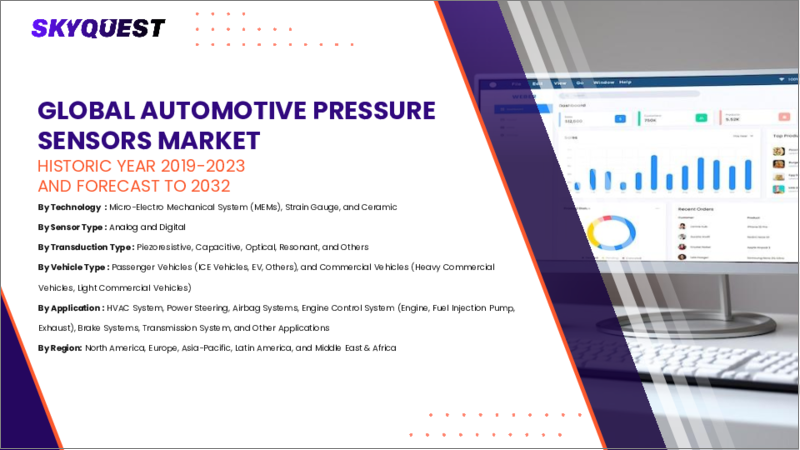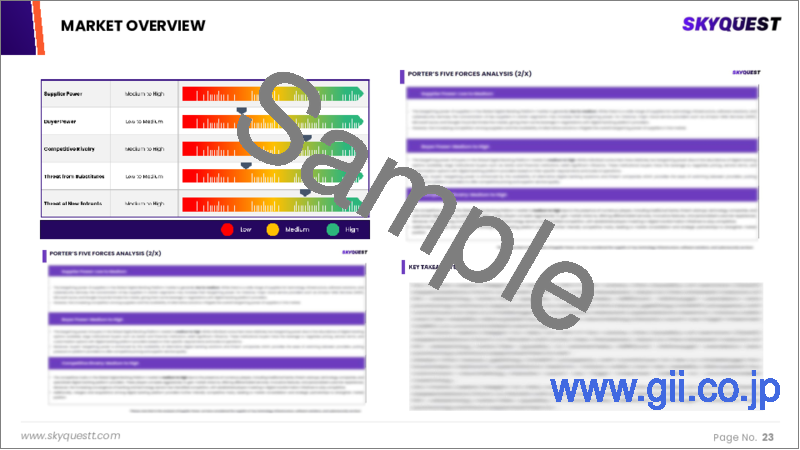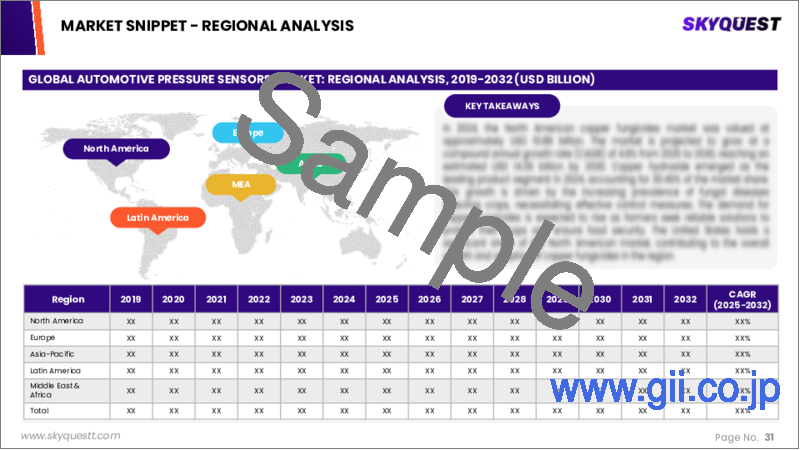|
|
市場調査レポート
商品コード
1603315
自動車用圧力センサーの市場規模、シェア、成長分析、自動車タイプ別、EVタイプ別、用途別、変換タイプ別、技術別、地域別 - 産業予測、2024年~2031年Automotive Pressure Sensors Market Size, Share, Growth Analysis, By Vehicle Type, By EV Type (Battery Electric Vehicle ), By Applications, By Transduction Type, By Technology, By Region - Industry Forecast 2024-2031 |
||||||
|
|||||||
| 自動車用圧力センサーの市場規模、シェア、成長分析、自動車タイプ別、EVタイプ別、用途別、変換タイプ別、技術別、地域別 - 産業予測、2024年~2031年 |
|
出版日: 2024年11月27日
発行: SkyQuest
ページ情報: 英文 220 Pages
納期: 3~5営業日
|
全表示
- 概要
- 目次
自動車用圧力センサーの世界市場規模は2022年に176億米ドルとなり、予測期間(2024-2031年)のCAGRは8.9%で、2023年の193億米ドルから2031年には382億米ドルに成長する見通しです。
世界の自動車用圧力センサー市場は、技術の進歩、安全規制、電気自動車(EV)の台頭により、大きな成長が見込まれています。タイヤ空気圧モニタリングシステム(TPMS)は、各タイヤの空気圧モニタリングセンサーを利用し、空気圧データを積極的に追跡して制御モジュールに中継することで車両の安全性を高めます。乗用車では安全対策が重視されており、衝突の衝撃や死亡事故を減らすことができるため、このような技術に対する需要が高まっています。非接触型3D磁気センサーなどのセンサー技術の革新は、精度、携帯性、耐久性を高め、自動車メーカーの進化する要求に応えています。さらに、自動車の排出ガス、安全性、燃費を改善することを目的とした厳しい政府規制が、タイヤ空気圧と排出ガスを監視するために自動車への圧力センサーの取り付けを義務付けているため、市場の成長をさらに促進しています。さらに、EV市場の急速な拡大により、バッテリーや暖房システムなど、さまざまな用途で圧力センサーの必要性が高まっています。EV分野が成長するにつれて、圧力センサーのニーズも高まっています。さらに、自律走行技術の出現により、アダプティブ・クルーズ・コントロールや衝突回避などの重要な機能に高度な圧力センサを統合する必要があります。そのため、自動車の安全性と自動化が進むにつれて、自動車用圧力センサー市場の繁栄が予想され、自動車の性能と安全基準の向上における重要性が強調されます。
目次
イントロダクション
- 調査の目的
- 調査範囲
- 定義
調査手法
- 情報調達
- 二次データと一次データの方法
- 市場規模予測
- 市場の前提条件と制限
エグゼクティブサマリー
- 世界市場の見通し
- 供給と需要の動向分析
- セグメント別機会分析
市場力学と見通し
- 市場概要
- 市場規模
- 市場力学
- 促進要因と機会
- 抑制要因と課題
- ポーター分析と影響
- 競争企業間の敵対関係
- 代替品の脅威
- 買い手の交渉力
- 新規参入業者の脅威
- 供給企業の交渉力
主な市場の考察
- 重要成功要因
- 競合の程度
- 主な投資機会
- 市場エコシステム
- 技術の進歩
- 規制情勢
- 特許分析
- バリューチェーン分析
- ケーススタディ分析
- 顧客と購買基準の分析
- PESTEL分析
- マクロ経済指標
- 市場の魅力指数
- 価格分析
自動車用圧力センサーの市場規模:車両タイプ別& CAGR(2024-2031)
- 市場概要
- 乗用車
- 商用車
自動車用圧力センサーの市場規模:EVタイプ別& CAGR(2024-2031)
- 市場概要
- バッテリー電気自動車(BEV)
- 燃料電池電気自動車(FCEV)
- ハイブリッド電気自動車(HEV)
- プラグインハイブリッド電気自動車(PHEV)
自動車用圧力センサーの市場規模:用途別& CAGR(2024-2031)
- 市場概要
- アンチロックブレーキシステム(ABS)
- エアバッグシステム
- 直接タイヤ空気圧監視システム
- エンジン制御システム
- エンジン
- 燃料噴射ポンプ
- 排気
- HVACシステム
- パワーステアリング
- 油圧パワーステアリング
- 電動油圧パワーステアリング(EHPS)
- トランスミッションシステム
- オートマチックトランスミッション(AT)
- オートマチックマニュアルトランスミッション(AMT)
- 無段トランスミッション(CVT)
- デュアルクラッチトランスミッション(DCT)
自動車用圧力センサーの市場規模:変換タイプ別& CAGR(2024-2031)
- 市場概要
- 圧電抵抗型圧力センサー
- 静電容量式圧力センサー
- 共振圧力センサー
- 光学式圧力センサー
- その他の圧力センサー
自動車用圧力センサーの市場規模:技術別& CAGR(2024-2031)
- 市場概要
- 圧力センサー
- MEMS圧力センサー
- ひずみゲージ圧力シニア
自動車用圧力センサーの市場規模& CAGR(2024-2031)
- 北米
- 米国
- カナダ
- 欧州
- 英国
- ドイツ
- スペイン
- フランス
- イタリア
- その他欧州地域
- アジア太平洋
- 中国
- インド
- 日本
- 韓国
- その他アジア太平洋地域
- ラテンアメリカ
- ブラジル
- その他ラテンアメリカ地域
- 中東およびアフリカ
- GCC諸国
- 南アフリカ
- その他中東・アフリカ
競合情報
- 上位5社の比較
- 主要企業の市場ポジショニング(2023年)
- 主な市場企業が採用した戦略
- 市場の最近の動向
- 企業の市場シェア分析(2023年)
- 主要企業の企業プロファイル
- 会社概要
- 製品ポートフォリオ分析
- セグメント別シェア分析
- 収益の前年比比較(2021-2023)
主要企業プロファイル
- NXP Semiconductors N.V.(Netherlands)
- TE Connectivity(Switzerland)
- Continental AG(Germany)
- Denso Corporation(Japan)
- Robert Bosch GmbH(Germany)
- Infineon Technologies AG(Germany)
- STMicroelectronics(Switzerland)
- Texas Instruments Incorporated(USA)
- Allegro Microsystems LLC(USA)
- CTS Corporation(USA)
- Elmos Semiconductor(Germany)
- Sensata Technologies(Attleboro, Massachusetts, USA)
結論と推奨事項
Global Automotive Pressure Sensors Market size was valued at USD 17.6 billion in 2022 and is poised to grow from USD 19.3 billion in 2023 to USD 38.2 billion by 2031, growing at a CAGR of 8.9% during the forecast period (2024-2031).
The global automotive pressure sensors market is poised for significant growth, driven by advances in technology, safety regulations, and the rise of electric vehicles (EVs). Tire Pressure Monitoring Systems (TPMS), which utilize pressure monitoring sensors in each tire, enhance vehicle safety by actively tracking and relaying pressure data to control modules. The emphasis on safety measures in passenger vehicles amplifies the demand for such technology, as it can reduce collision impacts and fatalities. Innovations in sensor technology, such as non-contact 3D magnetic sensors, are increasing accuracy, portability, and durability, catering to the evolving requirements of automakers. Moreover, strict governmental regulations aimed at improving vehicle emissions, safety, and fuel efficiency are further fueling market growth, as they mandate pressure sensor installations in vehicles for monitoring tire pressure and emissions. Additionally, the rapid expansion of the EV market is driving the necessity for pressure sensors in various applications, including battery and heating systems. As the EV sector grows, so does the need for pressure sensors. Furthermore, the advent of autonomous driving technologies necessitates the integration of sophisticated pressure sensors for critical functions such as adaptive cruise control and collision avoidance. Therefore, as vehicle safety and automation continue to advance, the automotive pressure sensors market is expected to thrive, highlighting its importance in enhancing vehicle performance and safety standards.
Top-down and bottom-up approaches were used to estimate and validate the size of the Global Automotive Pressure Sensors market and to estimate the size of various other dependent submarkets. The research methodology used to estimate the market size includes the following details: The key players in the market were identified through secondary research, and their market shares in the respective regions were determined through primary and secondary research. This entire procedure includes the study of the annual and financial reports of the top market players and extensive interviews for key insights from industry leaders such as CEOs, VPs, directors, and marketing executives. All percentage shares split, and breakdowns were determined using secondary sources and verified through Primary sources. All possible parameters that affect the markets covered in this research study have been accounted for, viewed in extensive detail, verified through primary research, and analyzed to get the final quantitative and qualitative data.
Global Automotive Pressure Sensors Market Segmental Analysis
Global Automotive Pressure Sensors Market is segmented by Vehicle Type, Vehicle Type, Application, Transduction Type, Technology, and Region. Based on Vehicle Type, the market is segmented into Passenger Cars, and Commercial Vehicles. Based on Application, the market is segmented into Antilock Braking System (ABS), Airbag System, Direct Tire Pressure Monitoring System, HVAC System, Power Steering, Transmission System. Based on Transduction Type, the market is segmented into Piezoresistive Pressure Sensors, Capacitive Pressure Sensors, Resonant Pressure Sensors, Optical Pressor Sensor, Other Pressure Sensors. Based on Technology, the market is segmented into Pressure Sensor, MEMS Pressure Sensor Strain Gauge Pressure Senior. Based on Region, the market is segmented into North America, Europe, Asia Pacific, Latin America and Middle East & and Africa.
Driver of the Global Automotive Pressure Sensors Market
The Global Automotive Pressure Sensors market is experiencing significant growth driven by the rising demand for precise pressure detection to enhance vehicle safety and efficiency. Modern safety systems now incorporate dual airbag pressure sensors, which are strategically placed in side doors to effectively communicate digital signals to the central airbag unit during collisions. Furthermore, these sensors play a crucial role in boosting engine performance by fine-tuning spark timing in both petrol and diesel engines. As a result, the heightened integration of pressure sensors in both engine systems and safety features is expected to propel market expansion in the coming years.
Restraints in the Global Automotive Pressure Sensors Market
The Global Automotive Pressure Sensors market faces significant challenges that may hinder its growth. Increasing costs associated with sensor production and limitations imposed by adverse weather conditions are major restraints. The focus on minimizing sensor size complicates efforts to lower costs, particularly for sensors employed in advanced driver assistance systems, which struggle to achieve target pricing. Furthermore, many sensors currently experience constraints in both signal bandwidth and measurement range, complicating the differentiation between genuine signals and system noise, such as obstacles on the road. These issues collectively pose significant barriers to the market's expansion potential.
Market Trends of the Global Automotive Pressure Sensors Market
The Global Automotive Pressure Sensors market is witnessing a significant trend toward the adoption of non-interacting 3D magnetic sensors, driven by automakers' desire to enhance vehicle performance and reliability. These advanced sensors are being favored over traditional potentiometers and optical systems for positioning mechanisms, due to their ability to mitigate damage and contamination errors, while providing accurate measurements in high-temperature environments. This evolution not only optimizes space but also facilitates innovative vehicle modifications by manufacturers like STMicroelectronics and Elmos. As the demand for more efficient and durable automotive components grows, the integration of 3D magnetic sensors is expected to accelerate, shaping the future of automotive technology.
Table of Contents
Introduction
- Objectives of the Study
- Scope of the Report
- Definitions
Research Methodology
- Information Procurement
- Secondary & Primary Data Methods
- Market Size Estimation
- Market Assumptions & Limitations
Executive Summary
- Global Market Outlook
- Supply & Demand Trend Analysis
- Segmental Opportunity Analysis
Market Dynamics & Outlook
- Market Overview
- Market Size
- Market Dynamics
- Driver & Opportunities
- Restraints & Challenges
- Porters Analysis & Impact
- Competitive rivalry
- Threat of substitute
- Bargaining power of buyers
- Threat of new entrants
- Bargaining power of suppliers
Key Market Insights
- Key Success Factors
- Degree of Competition
- Top Investment Pockets
- Market Ecosystem
- Technological Advancement
- Regulatory Landscape
- Patent Analysis
- Value Chain Analysis
- Case Study Analysis
- Customer & Buying Criteria Analysis
- PESTEL Analysis
- Macro-Economic Indicators
- Market Attractiveness Index
- Pricing Analysis
Global Automotive Pressure Sensors Market Size by Vehicle Type & CAGR (2024-2031)
- Market Overview
- Passenger Cars
- Commercial Vehicles
Global Automotive Pressure Sensors Market Size by EV Type & CAGR (2024-2031)
- Market Overview
- Battery Electric Vehicle (BEV)
- Fuel Cell Electric Vehicle (FCEV)
- Hybrid Electric Vehicle (HEV)
- Plug-In Hybrid Electric Vehicle (PHEV)
Global Automotive Pressure Sensors Market Size by Applications & CAGR (2024-2031)
- Market Overview
- Antilock Braking System (ABS)
- Airbag System
- Direct Tire Pressure Monitoring System
- Engine Control System
- Engine
- Fuel Injection Pump
- Exhaust
- HVAC System
- Power Steering
- Hydraulic Power Steering
- Electrohydraulic Power Steering (EHPS)
- Transmission System
- Automatic Transmission (AT)
- Automatic Manual Transmission (AMT)
- Continuously Variable Transmission (CVT)
- Dual-Clutch Transmission (DCT)
Global Automotive Pressure Sensors Market Size by Transduction Type & CAGR (2024-2031)
- Market Overview
- Piezoresistive Pressure Sensors
- Capacitive Pressure Sensors
- Resonant Pressure Sensors
- Optical Pressor Sensor
- Other Pressure Sensors
Global Automotive Pressure Sensors Market Size by Technology & CAGR (2024-2031)
- Market Overview
- Pressure Sensor
- MEMS Pressure Sensor
- Strain Gauge Pressure Senior
Global Automotive Pressure Sensors Market Size & CAGR (2024-2031)
- North America, (Vehicle Type, Ev Type, Applications, Transduction Type, Technology)
- US
- Canada
- Europe, (Vehicle Type, Ev Type, Applications, Transduction Type, Technology)
- UK
- Germany
- Spain
- France
- Italy
- Rest of Europe
- Asia-Pacific, (Vehicle Type, Ev Type, Applications, Transduction Type, Technology)
- China
- India
- Japan
- South Korea
- Rest of Asia Pacific
- Latin America, (Vehicle Type, Ev Type, Applications, Transduction Type, Technology)
- Brazil
- Rest of Latin America
- Middle East & Africa, (Vehicle Type, Ev Type, Applications, Transduction Type, Technology)
- GCC Countries
- South Africa
- Rest of Middle East & Africa
Competitive Intelligence
- Top 5 Player Comparison
- Market Positioning of Key Players, 2023
- Strategies Adopted by Key Market Players
- Recent Developments in the Market
- Company Market Share Analysis, 2023
- Company Profiles of All Key Players
- Company Details
- Product Portfolio Analysis
- Company's Segmental Share Analysis
- Revenue Y-O-Y Comparison (2021-2023)
Key Company Profiles
- NXP Semiconductors N.V. (Netherlands)
- Company Overview
- Business Segment Overview
- Financial Updates
- Key Developments
- TE Connectivity (Switzerland)
- Company Overview
- Business Segment Overview
- Financial Updates
- Key Developments
- Continental AG (Germany)
- Company Overview
- Business Segment Overview
- Financial Updates
- Key Developments
- Denso Corporation (Japan)
- Company Overview
- Business Segment Overview
- Financial Updates
- Key Developments
- Robert Bosch GmbH (Germany)
- Company Overview
- Business Segment Overview
- Financial Updates
- Key Developments
- Infineon Technologies AG (Germany)
- Company Overview
- Business Segment Overview
- Financial Updates
- Key Developments
- STMicroelectronics (Switzerland)
- Company Overview
- Business Segment Overview
- Financial Updates
- Key Developments
- Texas Instruments Incorporated (USA)
- Company Overview
- Business Segment Overview
- Financial Updates
- Key Developments
- Allegro Microsystems LLC (USA)
- Company Overview
- Business Segment Overview
- Financial Updates
- Key Developments
- CTS Corporation (USA)
- Company Overview
- Business Segment Overview
- Financial Updates
- Key Developments
- Elmos Semiconductor (Germany)
- Company Overview
- Business Segment Overview
- Financial Updates
- Key Developments
- Sensata Technologies (Attleboro, Massachusetts, USA)
- Company Overview
- Business Segment Overview
- Financial Updates
- Key Developments






